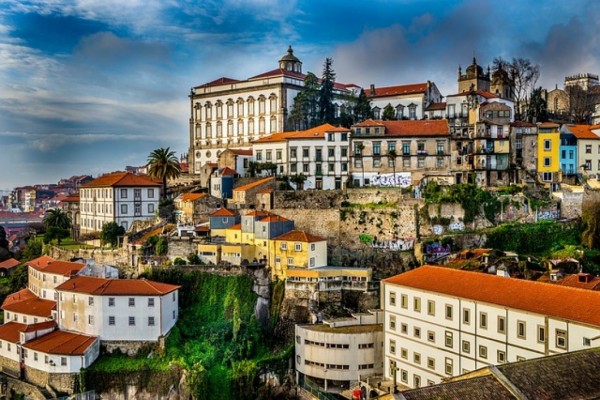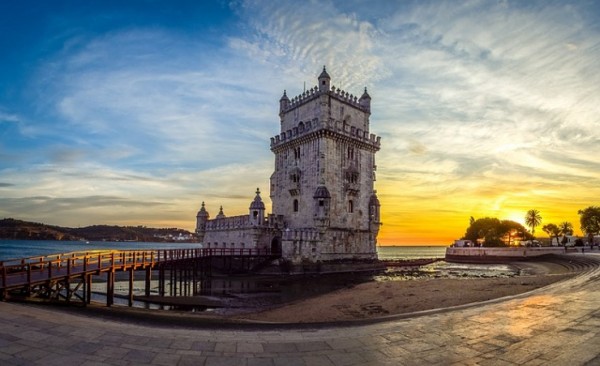Overview
Portugal is a country with something for everyone. From historic cities such as Porto and Coimbra to the rich cultural centre that is Lisbon, Portugal is crammed full of museums, monuments and stunning architecture.
Portugal is a southern European country on the Iberian Peninsula, bordering Spain. Its location on the Atlantic Ocean has influenced many aspects of its culture: salt cod and grilled sardines are national dishes, the Algarve's beaches are a major destination and much of the nation’s architecture dates to the 1500s–1800s, when Portugal had a powerful maritime empire.
This information has been compiled for your reference in good faith but please use this only as a general guide. We advise you to check with relevant authorities with regard to the latest requirement for passport, visa, travel advisory, entry restrictions, health requirements, local currency etc as these are subjected to change with without prior notice and our information given below may not be as updated.
Best time to go: The best time to visit Portugal is spring season which starts in February to find hills bedecked in seasonal flowers and almond groves awash with pretty pink blossom. Autumn is another best time to visit Portugal, especially for walkers and cyclists, as temperatures are still warm but crowds are a lot less. Mild warm weather, cool water and overwhelming sunny days are the most that can be expected from September. The ocean has a significant influence on the weather, due to which even the highest temperatures in the fall felt quite moderate.
Visa: New Zealand passport holder can enter Portugal for up to 90 days for tourist purposes without a visa. Passport should be valid for at least six months beyond your stay.
The First Journey Around the World was Led by a Portuguese Explorer
Currency: The currency in Portugal is the Euro, which makes it a very worry-free destination for many other Europeans to visit when it comes to money matters. The Euro (€) is a decimally-based currency, 1€ comprising of 100 cents. Bank notes of 500, 200, 100, 50, 20, 10 and 5 euros, and coins of 2 and 1 euros and 50, 20, 10, 5, 2, and 1 cents
You can exchange your foreign currency for Euros at the usual outlets, banks, post offices and foreign exchange counters. ATMs can be found in large towns especially in all the tourist areas. If you’ve got Master Card or Visa/Access, there are plenty of places to withdraw money or pay the bills at some places where accepted.
The Portuguese held the Longest Colonial Empire in Europe and the First in the World
Health: Portugal does not have any particular health risk. Foreign visitors should check at home whether you need vaccinations or not, but the general rule is that you won't. All travellers should be up to date on routine vaccinations when travelling to Portugal and keep your travel insurance up to date. Rabies is present in bats in Portugal as some of other European countries. However, it is not a major risk to most travellers.
Tempura was Never Initially Developed in Japan, but Introduced by the Portuguese
Food and drinks: Portuguese food doesn’t have the same high profile as other European cuisines, with menus usually relying on a traditional repertoire of grilled fish and meat, hearty stews and casseroles, and the ubiquitous salted cod (bacalhau), nearly all served with the same trio of accompaniments – rice, potatoes and salad. Grilled beef, chicken and pork are the mainstays of most menus – pork is especially loved in Portugal, whether it’s steaks, chops, ribs, belly or leg.
The Portuguese take their coffee very seriously, and you can order it in a variety of ways. A simple coffee (uma bica or um café) is small, black and strong, like an espresso; um carioca is also small and black, but weaker; uma chinesa is large, black and strong. There are variety of wines available and other sprits are available in many restaurants, hotels, pubs, etc.
Lisbon is The Oldest European Capital City
Clothing: The Portuguese dress conservatively. Women usually wear dresses, and men's clothing is based primarily around a jacket and tie. Business etiquette dictates suits and ties or sports jackets and ties for men. Women wear dresses, skirts and jackets or trouser suits. In the cities you will find the locals dress in a smart, casual and understated elegant style. Opt for a smart casual look with nice shoes. Jeans are very popular everywhere in Portugal, especially with younger people, but they are always smart and clean.
Portugal’s Vasco da Gama Bridge is the Longest in Europe
Language: Portuguese is an Indo-European Romance language and the official language of Portugal. Portuguese is used in several other countries, which have had contact with Portugal over the years. In Portugal, the language has ten unique dialects. Portuguese is used in all spheres of life in the country, from writing to most of the communication in business and daily interactions. Portuguese is also used in former colonies and territories of Portugal. English is the second most widely spoken language in Portugal. While the language has almost no native speakers within the country, English has grown to become a major language in tourist areas such as Lisbon.
Gratuities: Tipping is always customary not mandatory. Tipping 5% - 10% maximum in restaurants is standard, although tipping is only done if you are happy with the service. No tip is expected for a cup of coffee or a drink, although some people will leave the change rounding up from the nearest Euro. Few guidelines will help you as you can tip Taxi drivers: round up to the nearest 5 Euro on your total fare. Hotels: Give the bell boy 1-2 Euro per bag. Give house-keeping a few Euro at the end of the stay.
Portugal was the First Country to Begin Ending Capital Punishment
Safety & security: There is not much to worry about when it comes to safety and security travelling to Portugal. However as a generic note you need to take care of your personal safety and looking after your belongings so that you can have a safe and enjoyable time while travelling.
Airport tax: Your international air ticket should include airport tax on international departure.
Portugal Exports The Largest Quantity of Cork in the World
Internet: Internet facilities are available at almost in many places. Most hotels have it and internet cafes are commonly found in all major cities and tourist places.
Telephone: Portugal has a dialling code of +351 from New Zealand. While calling New Zealand from Portugal, you will need to dial +64…Pre-paid calling cards are sold in many shops and airport. If you want to call internationally, ask for an international calling card.
Portugal is one of the Top European Countries Breaking into Renewable Energy
Time Difference: Portugal has two time zones Lisbon is 11 hours behind New Zealand from April to September and 12 hours from October to March. Azores is 12 hours behind New Zealand from April to September and 13 hours from October to March.
Photography: It is normally forbidden to take photographs of government buildings, airports and buildings of military importance. Many museums prohibit photography without a permit; some prohibit only flash or tripod photography.
The largest Wave Surfed was in Nazaré Portugal
Electricity: In Portugal the standard voltage is 230 V and the frequency is 50 Hz. You can use your electric appliances in Portugal, if the standard voltage in your country is in between 220 - 240 V. The electrical sockets used in Portugal are type F. Few Hotels have adapters available which you could borrow free of charge during your stay but it might be a good idea to carry one from home. Please visit this website for more information on plugs: http://kropla.com/electric2.htm
Postage: Postal Services of Portugal, plc (Portuguese: CTT Correios de Portugal, S.A.) is the national postal service of Portugal.
The largest artificial underwater park in the world is in Portugal
Cities of interest
Lisbon
Lisbon is Portugal’s hilly, coastal capital city. From imposing São Jorge Castle, the view encompasses the old city’s pastel-colored buildings, Tagus Estuary and Ponte 25 de Abril suspension bridge. Nearby, the National Azulejo Museum displays 5 centuries of decorative ceramic tiles. Just outside Lisbon is a string of Atlantic beaches, from Cascais to Estoril.
The city’s compact, cobblestoned heart is easily explored on foot or via its old-fashioned trams and funiculars. The Moorish Alfama district has narrow, winding streets and taverns with fado singers. Chiado and its cafes, shopping and seafood restaurants adjoins Bairro Alto, known for nightlife. The Calouste Gulbenkian Museum complex, set amid serene gardens, displays noted art collections. On the waterfront are the ornate 16th-century Jerónimos Monastery and Belém Tower, and, to the east, the ultramodern Parque das Nações district and its massive Oceanário aquarium.
Porto
Porto is a coastal city in northwest Portugal known for its stately bridges and port wine production. In the medieval Ribeira (riverside) district, narrow cobbled streets wind past merchants’ houses and cafes. São Francisco Church is known for its lavish baroque interior with ornate gilded carvings. The palatial 19th-century Palácio de Bolsa, formerly a stock market, was built to impress potential European investors.
Clérigos Tower is the iconic baroque bell tower of Clérigos Church. An old tram follows the river to beachside bars in affluent Foz. Up the coast is fishing port Matosinhos, where seafood restaurants offer grilled sardines on the street. The 1886 Dom Luís iron bridge has a walkway that crosses the Douro River to the port wine lodges of Vila Nova de Gaia. São Bento train station's immense azulejo tile panels depict battles and rural life in Portugal. The famous Lello & Irmão bookstore has ornate art nouveau features, and the Serralves Museum traces the history of contemporary art.
Sintra
Sintra is a resort town in the foothills of Portugal’s Sintra Mountains, near the capital, Lisbon. A longtime royal sanctuary, its forested terrain is studded with pastel-colored villas and palaces. The Moorish- and Manueline-style Sintra National Palace is distinguished by dramatic twin chimneys and elaborate tilework. The hilltop 19th-century Pena National Palace is known for a whimsical design and sweeping views.
Also perched above the city is the Moorish fortress Castelo dos Mouros, whose winding battlements and towers were originally built in the Middle Ages. Near the town center, the Quinta da Regaleira is an early-20th-century manor whose turrets overlook lush parkland sheltering grottoes and moss-covered tunnels. Just outside town, 30 hectares of atmospheric gardens surround the Moorish-style Monserrate Palace. The nearby monastery of Convento dos Capuchos, nicknamed the “Cork Convent” for its cork-lined walls, was immortalized in a poem by the English writer Lord Byron.
Fátima
Fátima is a central Portuguese town that's home to the Sanctuary of Fátima, a Catholic pilgrimage site. The Capelinha das Aparições marks the spot where the Virgin Mary allegedly appeared in 1917. Other sacred sites include the Basílica de Nossa Senhora do Rosário, with its golden angels, and the modern church of Igreja da Santíssima Trindade. The Museu de Arte Sacra e Etnologia exhibits religious artifacts.
North of Portugal
Explore its most enchanting cities by joining this fascinating cultural tour.6 DAYS
The Best of Portugal
Adventure into a memorable tour around picturesque Portugal and spend 11 days discovering its most important cities and authentic villages, natural beauty, and rich history.11 DAYS
Wonders of Portugal
Join a three-day guaranteed departure tour in inspiring Portugal and enjoy a memorable journey through the Portuguese culture, history, and traditions.3 DAYS


